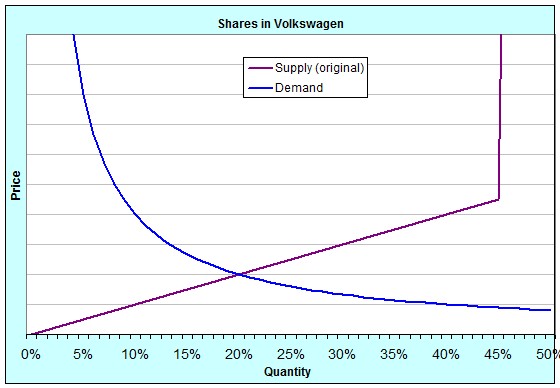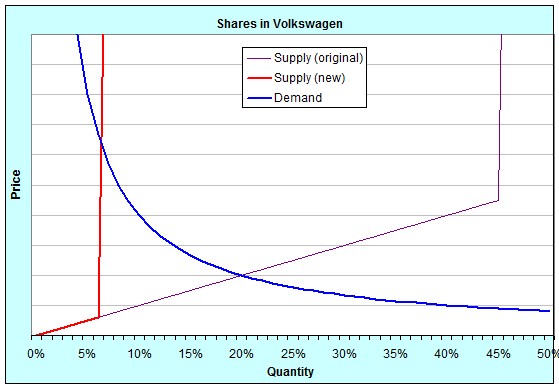Entirely for my own reference …
A demand function commonly used in macroeconomics is the following, derived from a Dixit-Stiglitz aggregator and exhibiting a constant own-price elasticity of demand ($$\gamma$$):
$$!Q_{it}=\left(\frac{P_{it}}{P_{t}}\right)^{-\gamma}Q_{t}$$
A demand-side shock can then be modelled as a change in the elasticity of demand:
$$!Q_{it}=\left(\frac{P_{it}}{P_{t}}\right)^{-\gamma D_{t}}Q_{t}$$
Where $$\ln\left(D_{t}\right)$$ is, say, Normally distributed and plausibly autocorrelated. We can rewrite this as a function of (natural) log deviations from long-run trends:
$$!Q_{it}=\overline{Q_{t}}e^{q_{t}-\gamma e^{d_{t}}\left(p_{it}-p_{t}\right)}$$
Where:
- Variables with a bar above them are long-run trends: $$\overline{X_{it}}$$
- Lower-case variables are natural log deviations from their long run trends (so that for small deviations, they may be thought of as the percentage difference from trend): $$x_{it}=\ln\left(X_{it}\right)-\ln\left(\overline{X_{it}}\right)$$
- The long-run trend of all prices is to equal the aggregate price: $$\overline{P_{it}}=\overline{P_{t}}$$
- The long-run trend of $$D_{t}$$ is unity
We’ll construct a quadratic approximation around $$q_{t}=p_{it}=p_{t}=d_{t}=0$$ but, first, a table of partial derivatives for a more general function:
| Function | Value at $$x=y=z=0$$ |
| $$f\left(x,y,z\right)=ae^{x+bye^{z}}$$ | $$a$$ |
| $$f_{x}\left(x,y,z\right)=ae^{x+bye^{z}}$$ | $$a$$ |
| $$f_{y}\left(x,y,z\right)=abe^{x+bye^{z}+z}$$ | $$ab$$ |
| $$f_{z}\left(x,y,z\right)=abye^{x+bye^{z}+z}$$ | $$0$$ |
| $$f_{xx}\left(x,y,z\right)=ae^{x+bye^{z}}$$ | $$a$$ |
| $$f_{yy}\left(x,y,z\right)=ab^{2}e^{x+bye^{z}+2z}$$ | $$ab^{2}$$ |
| $$f_{zz}\left(x,y,z\right)=abye^{x+bye^{z}+z}+ab^{2}y^{2}e^{x+bye^{z}+2z}$$ | $$0$$ |
| $$f_{xy}\left(x,y,z\right)=abe^{x+bye^{z}+z}$$ | $$ab$$ |
| $$f_{xz}\left(x,y,z\right)=abye^{x+bye^{z}+z}$$ | $$0$$ |
| $$f_{yz}\left(x,y,z\right)=abe^{x+bye^{z}+z}+ab^{2}ye^{x+bye^{z}+2z}$$ | $$ab$$ |
So that in the vicinity of $$x=y=z=0$$, the function $$f\left(x,y,z\right)$$ is approximated by:
$$!f\left(x,y,z\right)\simeq a + a\left(x+by\right) + a\left[\frac{1}{2}\left(x+by\right)^{2}+byz\right]$$
From which we can infer that:
$$!Q_{it}\simeq \overline{Q_{t}}\left[1+\left(q_{t}-\gamma\left(p_{it}-p_{t}\right)\right) + \frac{1}{2}\left(q_{t}-\gamma\left(p_{it}-p_{t}\right)\right)^{2}-\gamma\left(p_{it}-p_{t}\right)d_{t}\right]$$
If introduced to a profit function, the first-order components ($$q_{t}-\gamma\left(p_{it}-p_{t}\right)$$) would vanish as individual prices will be optimal in the long run.
Update (20 Jan 2010): Added the half in each of the last equations.

